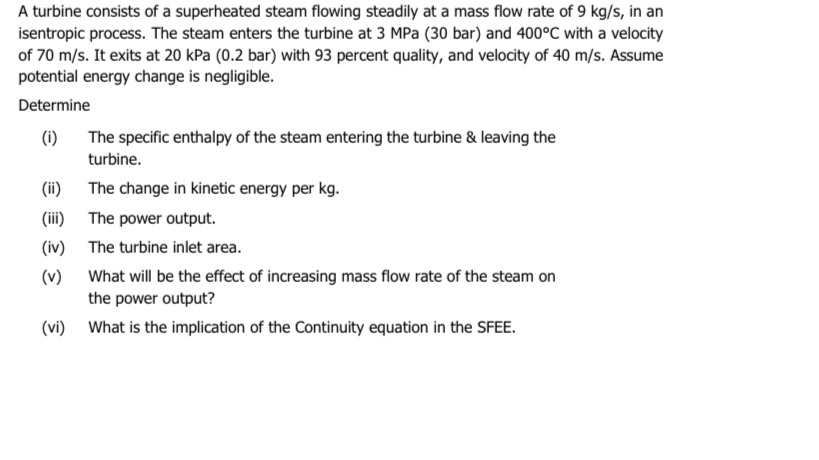A turbine consists of a superheated steam flowing steadily at a mass flow rate of 9 kg/s, in an isentropic process. The steam enters the turbine at 3 MPa (30 bar) and 400°C with a velocity of 70 m/s. It exits at 20 kPa (0.2 bar) with 93 percent quality, and velocity of 40 m/s. Assume potential energy change is negligible. Determine (i) The specific enthalpy of the steam entering the turbine & leaving the turbine. (ii) The change in kinetic energy per kg. (iii) The power output. (iv) The turbine inlet area. (v) What will be the effect of increasing mass flow rate of the steam on the power output? (vi) What is the implication of the Continuity equation in the SFEE.
A turbine consists of a superheated steam flowing steadily at a mass flow rate of 9 kg/s, in an isentropic process. The steam enters the turbine at 3 MPa (30 bar) and 400°C with a velocity of 70 m/s. It exits at 20 kPa (0.2 bar) with 93 percent quality, and velocity of 40 m/s. Assume potential energy change is negligible. Determine (i) The specific enthalpy of the steam entering the turbine & leaving the turbine. (ii) The change in kinetic energy per kg. (iii) The power output. (iv) The turbine inlet area. (v) What will be the effect of increasing mass flow rate of the steam on the power output? (vi) What is the implication of the Continuity equation in the SFEE.
Elements Of Electromagnetics
7th Edition
ISBN:9780190698614
Author:Sadiku, Matthew N. O.
Publisher:Sadiku, Matthew N. O.
ChapterMA: Math Assessment
Section: Chapter Questions
Problem 1.1MA
Related questions
Question
please check attach file

Transcribed Image Text:A turbine consists of a superheated steam flowing steadily at a mass flow rate of 9 kg/s, in an
isentropic process. The steam enters the turbine at 3 MPa (30 bar) and 400°C with a velocity
of 70 m/s. It exits at 20 kPa (0.2 bar) with 93 percent quality, and velocity of 40 m/s. Assume
potential energy change is negligible.
Determine
(i)
The specific enthalpy of the steam entering the turbine & leaving the
turbine.
(ii)
The change in kinetic energy per kg.
(iii)
The power output.
(iv)
The turbine inlet area.
(v)
What will be the effect of increasing mass flow rate of the steam on
the power output?
(vi)
What is the implication of the Continuity equation in the SFEE.
Expert Solution
This question has been solved!
Explore an expertly crafted, step-by-step solution for a thorough understanding of key concepts.
Step by step
Solved in 4 steps with 1 images

Knowledge Booster
Learn more about
Need a deep-dive on the concept behind this application? Look no further. Learn more about this topic, mechanical-engineering and related others by exploring similar questions and additional content below.Recommended textbooks for you

Elements Of Electromagnetics
Mechanical Engineering
ISBN:
9780190698614
Author:
Sadiku, Matthew N. O.
Publisher:
Oxford University Press

Mechanics of Materials (10th Edition)
Mechanical Engineering
ISBN:
9780134319650
Author:
Russell C. Hibbeler
Publisher:
PEARSON

Thermodynamics: An Engineering Approach
Mechanical Engineering
ISBN:
9781259822674
Author:
Yunus A. Cengel Dr., Michael A. Boles
Publisher:
McGraw-Hill Education

Elements Of Electromagnetics
Mechanical Engineering
ISBN:
9780190698614
Author:
Sadiku, Matthew N. O.
Publisher:
Oxford University Press

Mechanics of Materials (10th Edition)
Mechanical Engineering
ISBN:
9780134319650
Author:
Russell C. Hibbeler
Publisher:
PEARSON

Thermodynamics: An Engineering Approach
Mechanical Engineering
ISBN:
9781259822674
Author:
Yunus A. Cengel Dr., Michael A. Boles
Publisher:
McGraw-Hill Education

Control Systems Engineering
Mechanical Engineering
ISBN:
9781118170519
Author:
Norman S. Nise
Publisher:
WILEY

Mechanics of Materials (MindTap Course List)
Mechanical Engineering
ISBN:
9781337093347
Author:
Barry J. Goodno, James M. Gere
Publisher:
Cengage Learning

Engineering Mechanics: Statics
Mechanical Engineering
ISBN:
9781118807330
Author:
James L. Meriam, L. G. Kraige, J. N. Bolton
Publisher:
WILEY